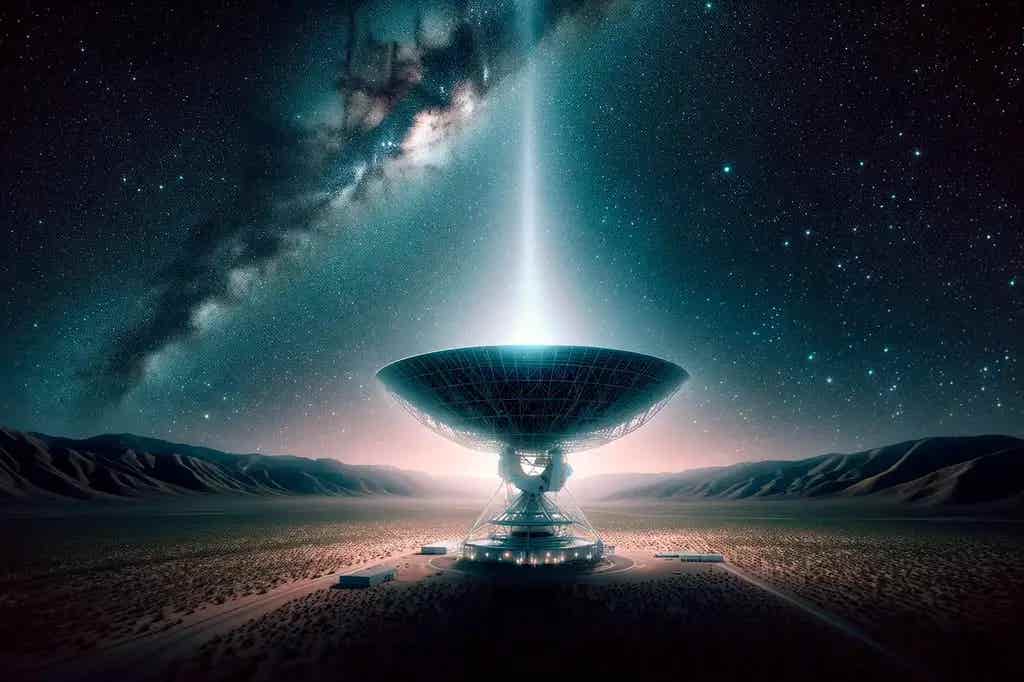Scientists detect ancient cosmic signal from 8 billion light-years away
Astronomers have identified a cosmic signal so ancient and powerful that it challenges our current understanding of the universe.

[Nov. 1, 2023: Staff Writer, The Brighter Side of News]
Astronomers have identified a cosmic signal so ancient and powerful that it challenges our current understanding of the universe. (CREDIT: Creative Commons)
In a groundbreaking discovery, astronomers have identified a cosmic signal so ancient and powerful that it challenges our current understanding of the universe. This mysterious signal, a fast radio burst (FRB), originated from a distant corner of the cosmos, taking a staggering 8 billion years to reach Earth.
Fast radio bursts are short-lived yet incredibly intense pulses of radio waves. To put it into perspective, think of them as cosmic flares that emit the same kind of radiation as your cell phone or microwave. Spotting them, however, is a monumental task. "They last only a small fraction of a second," says Ryan Shannon from Swinburne University of Technology in Australia, likening the search to "finding a needle in a haystack."
The Significance of FRB 20220610A
The FRB identified in the recent study, designated as FRB 20220610A, is significant for several reasons:
It's Old and Distant: The burst happened about 8 billion years ago, making it the most ancient and distant FRB detected to date.
Related Stories:
High Energy: It showcased unusually high energy, thus challenging current theories about how FRBs are produced.
Only about 50 FRBs have been detected so far, and their origin remains one of the universe's biggest mysteries. "Given the intensity of their emission, it's astonishing that they come from distant galaxies," Shannon explains. To date, the only sources with similar emissions—known as pulsars—are located within our Milky Way and are a trillion times less potent.
Yet, these enigmatic bursts are more than just cosmic riddles. They carry the imprint of all the gas they've traversed, making them invaluable for studying the matter between galaxies. "Understanding this matter is essential, as it shapes galaxies and fuels star formation," adds Shannon.
This artist’s impression (not to scale) illustrates the path of the fast radio burst FRB 20220610A from its distant source all the way to Earth in one of the Milky Way’s spiral arms. (CREDIT: M. Kornmesser / ESO)
There's a prevailing theory suggesting that FRBs might be birthed by magnetars—young neutron stars boasting extremely powerful magnetic fields. Neutron stars are fascinating; they have the sun's mass but are only the size of a small city. Shannon mentions that a magnetar within our galaxy produced a burst similar to an FRB in 2020, supporting this theory.
However, some FRBs come from areas believed to lack magnetars, hinting at diverse origins for these bursts. "The possibility of multiple sources is exciting," Shannon remarks.
A Monumental Discovery Down Under
FRB 20220610A was detected by the Australian SKA Pathfinder (ASKAP), a radio telescope situated in a remote region of Western Australia. Its isolation minimizes interference from human-made signals, making it perfect for hunting FRBs.
Shannon praises ASKAP's capabilities, stating that it "pinpointed the burst to a location near the Sculptor constellation, allowing us to determine the galaxy from which the FRB originated."
Researchers observe the burst FRB 20220610A and localize it to a morphologically complex host galaxy system at redshift 1.016 ± 0.002. (CREDIT: Science)
This finding not only set a new distance record for FRBs but also confirmed their existence in extremely distant galaxies. Furthermore, the burst provided clues about its journey. "It showed evidence of passing through a considerable amount of gas, which was surprisingly calm. And despite its distance, it was exceptionally bright," Shannon notes.
Incredibly, FRB 20220610A emitted more energy in mere milliseconds than our sun does in three decades.
Although it's still uncertain whether the burst originated from a single galaxy or a cluster, its implications are profound. According to Shannon, this discovery confirms that FRBs can offer insights into the universe's early days and the structure of the cosmic web. With advancements in telescopic technology, we can expect to detect FRBs from even farther reaches of the cosmos.
Researchers use the burst energy of 2 × 1042 erg to revise the empirical maximum energy of an FRB. (CREDIT: Science)
Moreover, the intensity of this FRB compels scientists to rethink their theories on how such powerful emissions are generated.
In the vast expanse of the universe, these bursts serve as beacons, illuminating the mysteries of the cosmos and guiding our quest for knowledge. As more of these enigmatic signals are uncovered, our understanding of the universe is bound to expand.
Note: Materials provided above by The Brighter Side of News. Content may be edited for style and length.
Like these kind of feel good stories? Get the Brighter Side of News' newsletter.



